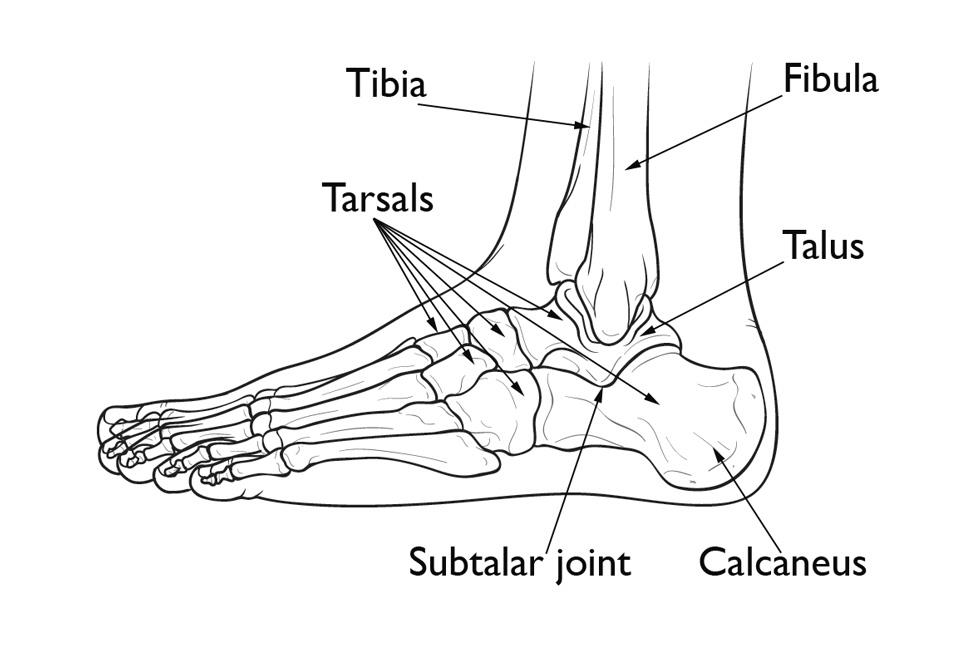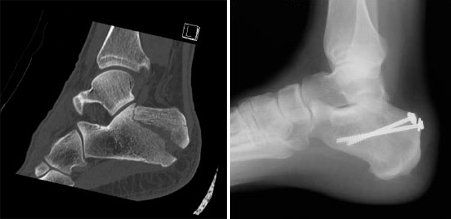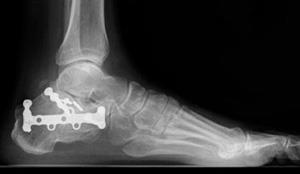Foot & Ankle
Calcaneus Fractures
The calcaneus, also known as the heel bone, is the largest bone in the foot and forms the foundation of the ankle joint. A calcaneus fracture refers to a break or crack in this bone, often caused by high-energy trauma, such as a fall from height, a motor vehicle accident, or a sports injury.
Understanding Calcaneus Fractures
The calcaneus plays a vital role in weight-bearing and movement, meaning that fractures to this area can lead to significant long-term complications if not treated properly.
Fractures of the calcaneus typically fall into two main categories:
- Intra-Articular Fractures: These fractures affect the joint surface of the calcaneus, which can lead to long-term issues like arthritis if not treated correctly.
- Extra-Articular Fractures: These fractures occur outside the joint surface and may not affect long-term foot function as severely, though they still cause significant pain and can lead to complications if left untreated.
Timely and accurate diagnosis followed by appropriate treatment is crucial to restore function, relieve pain, and prevent future complications such as chronic pain and joint instability.

Causes and Risk Factors
Calcaneus fractures are most commonly caused by high-impact trauma or accidents. Risk factors that contribute to these injuries include:
- Falls from Height: One of the leading causes of calcaneus fractures, particularly when landing directly on the feet from a height (e.g., falling off a ladder or from a height in sports).
- Motor Vehicle Accidents: The feet often bear the brunt of impact during car accidents, leading to fractures of the calcaneus.
- Sports Injuries: High-impact activities, such as football, rugby, or jumping, increase the risk of calcaneus fractures, especially when landing forcefully on the foot.
- Osteoporosis: Weakened bones, a common condition among older adults, can make the calcaneus more prone to fractures even with relatively minor trauma.
- Inadequate Footwear: Poorly fitted shoes or inappropriate footwear, especially those without sufficient arch support or cushioning, can increase the risk of injury to the heel.
Certain factors can elevate the risk of a calcaneus fracture:
- Age: Adults between 20 and 50 years old, especially those engaged in high-impact activities or sports, are more likely to sustain a calcaneus fracture.
- Previous Foot Injuries: Individuals with a history of foot or ankle injuries are more likely to suffer subsequent fractures due to weakened bone structure.
- Obesity: Increased body weight places additional strain on the feet, particularly on the calcaneus, which is responsible for bearing a significant amount of body weight.
Symptoms of Calcaneus Fractures
The symptoms of a calcaneus fracture depend on the severity and location of the injury but generally include:
- Pain: Intense pain in the heel and back of the foot, especially with weight-bearing or activity.
- Swelling: Significant swelling, typically around the heel and ankle, may occur immediately after the injury.
- Bruising: Discolouration around the heel and, in severe cases, the bottom of the foot.
- Deformity: In displaced fractures, the foot may appear deformed, and there may be visible misalignment of the heel.
- Inability to Bear Weight: Difficulty or inability to walk or bear weight on the affected foot due to pain and instability.
- Limited Mobility: Reduced range of motion, particularly when trying to flex or point the toes.
If you experience any of these symptoms after trauma, it's essential to seek immediate medical attention. Early diagnosis and treatment are key to preventing complications.
Diagnosis of Calcaneus Fractures
Accurate diagnosis of a calcaneus fracture requires a thorough clinical evaluation. Dr. Ryan du Sart will assess the foot for swelling, tenderness, and deformity. Imaging tests are necessary to confirm the diagnosis and assess the severity of the injury:
- X-rays: The first-line imaging tool to assess fractures in the calcaneus. X-rays help identify fracture patterns and determine whether the fracture is intra-articular or extra-articular.
- CT Scans: For complex fractures, a CT scan provides detailed 3D images of the calcaneus, helping to assess the extent of the injury and bone displacement.
- MRI: If there are concerns about associated soft tissue injuries (such as ligament tears or cartilage damage), an MRI may be used to provide further insight into the injury.
Treatment Options for Calcaneus Fractures
The treatment approach for a calcaneus fracture depends on the severity of the injury and the patient’s activity level. Dr. Ryan du Sart offers both non-surgical and surgical treatment options to help ensure a successful recovery.
Non-Surgical Treatment
For non-displaced or mild fractures, non-surgical management is often effective. Treatment typically includes:
- Rest and Immobilisation: The affected foot is immobilised using a cast, boot, or splint to protect the bone and promote healing.
- Ice and Elevation: Applying ice and elevating the foot can reduce swelling and pain in the immediate aftermath of the injury.
- Medications: Pain management with paracetamol or NSAIDs (non-steroidal anti-inflammatory drugs) to reduce discomfort and inflammation.
- Non-weight Bearing: The foot is kept non-weight bearing for several weeks to ensure the fracture heals properly.
Surgical Treatment
In cases where the fracture is displaced, intra-articular, or fails to heal with conservative treatment, surgery may be necessary. Surgical options include:
- Open Reduction and Internal Fixation (ORIF): This procedure involves realigning the bones and using plates, screws, or rods to stabilise the fracture during the healing process. ORIF is commonly used for displaced fractures.
- Bone Grafting: In cases of severe fractures or significant bone loss, bone grafting may be performed to encourage healing by stimulating the natural repair process.
- External Fixation: For more complex fractures or fractures with soft tissue damage, external fixation devices may be used to hold the bones in place during healing.
Dr. du Sart uses minimally invasive techniques whenever possible, which can reduce recovery time and improve surgical outcomes.


Recovery and Rehabilitation
The recovery process depends on the type of fracture and the treatment used. Typical recovery steps include:
- Immobilisation: For 6-8 weeks, the foot is immobilised in a cast or boot, with no weight-bearing activity during this period.
- Gradual Weight-Bearing: Once the fracture has healed sufficiently, Dr. du Sart will guide you through a gradual return to weight-bearing activities, typically using a walking boot or stiff-soled shoe .
- Physical Therapy: Rehabilitation exercises will help restore strength, flexibility, and mobility, reducing the risk of complications and ensuring proper function is restored .
- Full Recovery: Full recovery can take 3-6 months, with athletes or individuals involved in high-impact activities requiring more time to regain strength and function.
Preventing Future Injuries
Although not all calcaneus fractures can be prevented, there are key strategies to reduce the risk of injury:
- Proper Footwear: Well-fitted, supportive shoes can protect the foot and help prevent heel injuries.
- Fall Prevention: Reducing the risk of falls by using handrails, avoiding slippery surfaces, and taking care when walking can help prevent calcaneus fractures .
- Strengthening Exercises: Foot and leg strengthening exercises can help stabilise the foot and reduce the risk of fractures in the future.
- Gradual Increase in Activity: Slowly increasing your physical activity level and warming up before exercise can help prevent overuse injuries.
Why Choose Dr. Ryan du Sart?
Dr. Ryan du Sart is an internationally trained, fellowship-trained orthopaedic surgeon with extensive experience in diagnosing and treating foot and ankle fractures, including calcaneus fractures. His patient-centred approach ensures tailored treatment plans designed to meet the needs and goals of each individual patient, ensuring the best possible outcomes for recovery.
Book a Consultation
If you’ve suffered a calcaneus (heel bone) fracture or are experiencing persistent heel pain, don’t delay seeking treatment. Early diagnosis and intervention are essential for optimal recovery and prevention of long-term complications. Schedule a consultation with Dr. Ryan du Sart today.
Phone: (08) 9779 9767
Email: admin@ryandusart.com.au
Locations:
6 Higgins Street, South Bunbury, WA 6230
20 Prince Street, Busselton, WA 6280
References:
- American Academy of Orthopaedic Surgeons (AAOS). (2020). Calcaneus fractures: Diagnosis and treatment.https://www.aaos.org
- Foot and Ankle International. (2019). Management of calcaneus fractures.https://journals.sagepub.com
- Cleveland Clinic. (2021). Calcaneus fractures: Symptoms and treatment.https://my.clevelandclinic.org
- Royal Australian College of Surgeons (RACS). (2020). Foot and Ankle Trauma.https://www.surgeons.org

